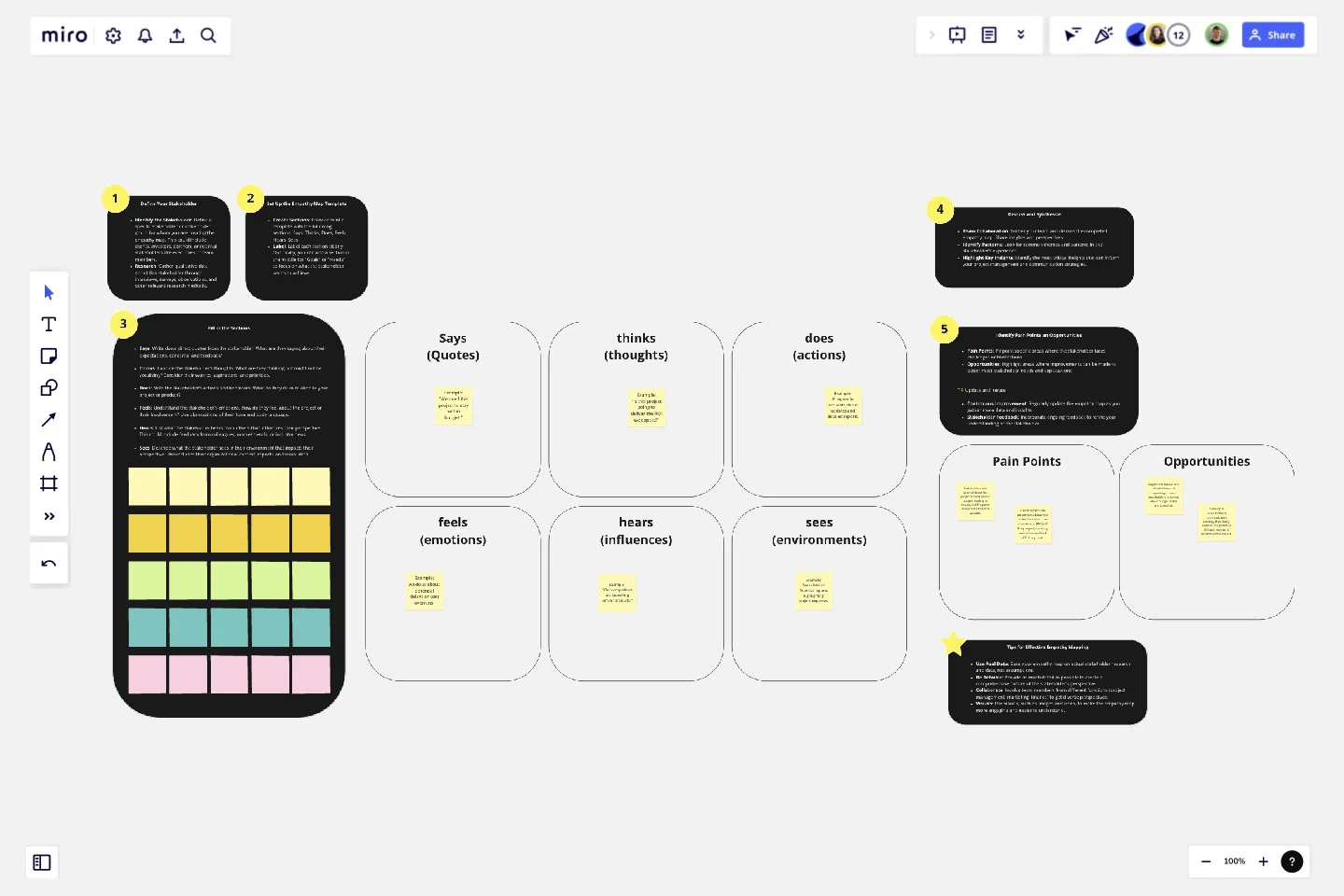Empathy Map for Stakeholders
The Empathy Map for Stakeholders template is a strategic tool designed to help teams gain a deep understanding of their stakeholders' perspectives, needs, and concerns.
This template is particularly useful for aligning project goals with stakeholder expectations, enhancing communication, and fostering stronger relationships. It facilitates a stakeholder-centric approach, ensuring that project decisions and strategies are informed by stakeholder insights.
Sections of the Template
Says: Captures direct quotes and statements from the stakeholder about their expectations, concerns, and feedback.
Thinks: Encompasses the stakeholder's internal thoughts and reflections, including their worries, aspirations, and priorities.
Does: Observes and notes the stakeholder's actions and behaviors in relation to your project or product.
Feels: Identifies the emotional responses and feelings of the stakeholder, inferred from their tone and body language.
Hears: Records what the stakeholder hears from others that influences their perspective, such as feedback from colleagues, market trends, or industry news.
Sees: Describes the stakeholder's environment and visual context, including organizational context, reports, and visual data.
Why Use This Template?
Stakeholder-Centric Insights:
Benefit: Helps teams focus on the stakeholder’s perspective, leading to more relevant and aligned project strategies.
Outcome: Projects and initiatives that better meet stakeholder needs and expectations, enhancing overall support and engagement.
Improved Communication:
Benefit: Encourages clear and effective communication by providing a shared understanding of stakeholder insights.
Outcome: More cohesive and integrated project management efforts, reducing misunderstandings and fostering collaboration.
Identifying Pain Points and Opportunities:
Benefit: Enables teams to pinpoint specific stakeholder challenges and areas for improvement.
Outcome: Targeted actions that address stakeholder pain points, improving project outcomes and stakeholder satisfaction.
Actionable Insights:
Benefit: Translates qualitative data into clear, actionable insights that can drive project decisions.
Outcome: More informed and effective project strategies that are aligned with stakeholder needs.
Visual and Intuitive:
Benefit: The visual format makes it easy to understand and communicate stakeholder insights.
Outcome: Simplified and effective communication among team members and stakeholders, facilitating better decision-making.
The Empathy Map for Stakeholders template is an essential tool for any team looking to create stakeholder-centered projects and initiatives. By leveraging this template, teams can gain a deeper understanding of their stakeholders, enhance communication, and drive more effective and impactful project decisions.
This template was created by Anthony.
Get started with this template right now.
Async Roadmap Sharing
Works best for:
Roadmaps, Planning, Mapping
Async Roadmap Sharing template facilitates asynchronous collaboration on roadmap planning and execution. By providing a centralized platform for sharing updates, feedback, and insights, teams can ensure alignment and transparency across distributed teams. This template promotes flexibility and inclusivity, allowing team members to contribute to roadmap discussions at their own pace and asynchronously across different time zones.
User Flow Example
Works best for:
Flowcharts, Mapping, Diagrams
The User Flow Example template offers a visual representation of a typical user flow within a digital product or service. It provides elements for documenting user interactions, navigation paths, and decision points along the user journey. This template enables UX designers and product teams to understand user behavior, identify pain points, and optimize the user experience. By providing a concrete example of user flow, the User Flow Example template serves as a valuable reference for designing intuitive and engaging digital experiences that meet user needs effectively.
UML Class E-Commerce System Template
Works best for:
UML
The UML Class E-Commerce System Template streamlines the process of creating and visualizing the class structure of an e-commerce system. It provides a comprehensive framework that includes typical online shop features such as product listings, inventory management, shopping carts, orders, payments, and shipping details. This template facilitates a clear understanding of how these elements interact during an online sales transaction, making it an invaluable tool for teams working on e-commerce projects. By using this template, teams can save time, enhance collaboration, and ensure that their system architecture is robust and efficient, ready to adapt to their business's evolving needs.
Product Roadmap Template
Works best for:
Product Management, Roadmaps
Product roadmaps help communicate the vision and progress of what’s coming next for your product. It’s an important asset for aligning teams and valuable stakeholders – including executives, engineering, marketing, customer success, and sales – around your strategy and priorities. Product roadmapping can inform future project management, describe new features and product goals, and spell out the lifecycle of a new product. While product roadmaps are customizable, most contain information about the products you’re building, when you’re building them, and the people involved at each stage.
Community Building: A 5 Step Roadmap
Works best for:
Roadmap, Planning, Mapping
Use this five step process for building a community development roadmap.
Mental Model Template
Works best for:
Business Management, Mind Mapping, Diagrams
Smart solutions and strong, strategic decisions. The best organizations make both, and a mental model is designed to help them do it. We give you a fast and easy way to try it out — just fill out our ready-made, flexible template and add sticky notes, shapes, and arrows to create a powerful map.
